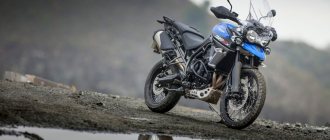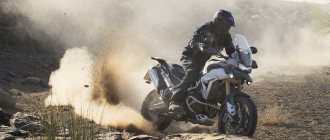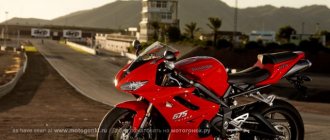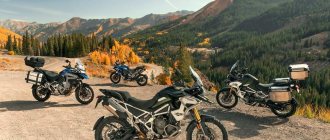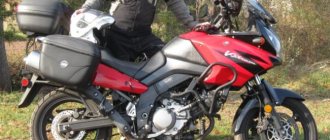Remember the joke about crossing an owl with a cow? As a result of this bold experiment, the genes of the parent individuals gave birth to a formidable fighting machine (night “bomber”). Is it possible to get a “tourenduro” if you “mix the blood” of a sportbike and a “street”?.. PDF version
Every turn can hide surprises
What the hell is a “tour”, and even more so an “enduro”! From the very first moments in the saddle, the Triumph Tiger 1050 leaves no doubt about its sportbike and streetfighter roots. Acceleration in lower gears is such that you have to “bite” your inner thighs into the saddle and tank so as not to hang on the steering wheel like a “flag of shame.” There are no dips or catches, just a smooth flow of power. The sweetest part of this flow is in the 7-8t range. rpm However, the character of the engine cannot be called “evil”.
Triumph Tiger 1050 allows the pilot to focus on beauty, not just handling
The torque at the bottom of the liter-and-hook engine is moderate, and the transition from idle to minimum power occurs without jerking and is completely predictable, which indicates the “polishness” of the fuel injection control electronics. Thanks to the friendly nature of the engine, the motorcycle easily storms through city traffic jams and difficult technical sections where fine dosing of power at low speeds is required.
A carbon muffler was installed on the tested Triumph Tiger 1050
The characteristic exhaust sound of a three-cylinder in-line engine, in tonality, occupies a logical place between “fours” and “twins”. When actively picking up speed, the engine does not squeal like a hysterical “four”, but also does not rattle like the “buckets” of V-shaped “twos”. The tuning carbon muffler installed on the test subject turned out to be quite quiet, which lovers of long trips will appreciate. But to inveterate hooligans, raised on Yoshimura's "straight streams", his "voice" may seem a little dry.
Family ties with sportbikes can also be traced in the operation of the gearbox. Switching occurs accurately and clearly, without the slightest backlash and, especially, “misconnections” and false “neutrals”. The gear ratios are chosen well, thanks to which the bike accelerates confidently in any mode. However, to increase aggressiveness and improve acceleration dynamics, it does not hurt to replace the sprockets according to the formula “-1” at the front and “+2” at the rear.
Excellent handling of the Triumph Tiger 1050 is ensured by alloy wheels and a rigid fork
Triumph is rightly renowned for its ability to build bikes that handle amazingly well, and the Tiger is no exception. A sportbike-style rigid frame, swingarm and inverted fork guarantee control over the vehicle in any road conditions. Be it difficult turns of a mountain “serpentine”, high-speed sections “over two hundred”, or a “killed” primer with
The Triumph Tiger 1050 swingarm could easily be part of an aggressive superbike
10 cm holes. However, when driving at a high pace on imperfect asphalt, there is a feeling of some roughness in the suspension's response to bumps. The likely reason for this is the rather heavy cast wheels and the manufacturer’s attempt to fit into a limited budget. Apparently, this is why the monoshock absorber did not receive the compression damping adjustment unit, and in
The Triumph Tiger 1050 has one feather for compression damping and the other for rebound
the fork compression and rebound settings were spaced between the “feathers”. The adjusting screws of these units do not have the usual “clicks”, which makes their adjustment a little difficult.
Successful steering geometry and perfect balance despite the high center of gravity made the motorcycle very obedient.
Triumph Tiger 1050 easily digests imperfect asphalt and gravel
The bike steers well both in “fast” asphalt roads and at “pedestrian” speeds, allowing you to accurately maneuver between potholes and boulders when riding off asphalt. Despite the lack of a steering damper, the unit is stable even during aggressive acceleration on uneven surfaces. Only at speeds above 150 km/h does stability become excessive, and a noticeable force will need to be applied to the wide steering wheel to force the Tiger to actively turn.
The Triumph Tiger 1050 features four-piston radial calipers at the front.
Triumph brakes are some of the best in the class. The front “jaws”, in full accordance with sports traditions, can easily lift the bike onto the front wheel - the effort of two fingers is enough. The rear brakes also did not cause any complaints. Reinforced brake hoses were installed on the motorcycle directly from the factory, and feedback when
The Triumph Tiger 1050 is equipped with a twin-piston floating caliper brake at the rear
braking is very good. Thanks to this, the ABS system rarely activated on asphalt. Because of this, it was necessary to specially provoke a blockage to make sure that it was working.
When it was possible to force the ABS to react, the braking distance felt not much longer than what could have been achieved without the help of electronics. It’s nice that braking didn’t become “ragged”, as happens with some systems from other manufacturers. The motorcycle only actively squatted on the front wheel, while maintaining complete stability and controllability, and the anti-lock operation was only indicated by pulsations of the brake lever. The only “minus” is the inability to disable ABS, which further shifts the scope of the Tiger towards asphalt.
Triumph Tiger 1050 fairing effectively deflects raindrops
Comfort behind the wheel of the Triumph Tiger is excellent. The wind protection works well up to 180 km/h; at higher speeds the pilot will have to lean forward a little so that his head is less affected by the wind. At maximum speed (about 220 km/h), the fairing glass makes noise, but this inconvenience can be easily and cheaply solved with the help of earplugs.
The Triumph Tiger 1050 saddle is very comfortable and will keep your buns comfortable for a long time
The saddle of the “British Tiger” is very comfortable and will allow both the pilot and the passenger to travel an impressive distance without “bread” dramas. A small “step” helps you stay in the saddle during vigorous acceleration and relieves stress on your back when riding with a backpack. But the height and width of the saddle are quite large, so even pilots of average height will have a difficult time. It is especially difficult to turn a motorcycle on narrow mountain roads with a steep slope, where there is a reasonable desire to protect yourself with your legs, but due to the height of the saddle this is not always possible.
For riding while standing, the Triumph Tiger 1050 steering wheel is a little low
The driving position is almost straight, “commander”, and with good visibility. The legs are slightly bent at the knees, thanks to which they practically do not get tired and do not go numb. Unfortunately, riding the Triumph Tiger while standing is uncomfortable due to the low “road” handlebar. Fortunately, the steering wheel is easy to replace with a higher tuning one. And at the same time, get rid of microscopic and absolutely useless tuning mirrors “a la carbon” in favor of original ones or at least just working ones.
Aluminum sliders installed on Triumph Tiger 1050
When rolling a heavy bike in inconvenient places and struggling with an insidiously high center of gravity, it is joyful to realize that the “insurance” against “crooked” or simply tired hands has already been paid for and installed: aluminum sliders with the help of durable aluminum plates are securely screwed directly to the engine. In addition to mirrors and sliders, the Tiger had xenon from tuning. Unfortunately, it does not illuminate the road enough, and lovers of active night driving will have to think about additional lighting.
Another minor drawback is the lack of a central stand. But in the asphalt context, it cannot be considered fundamental and should rather be classified as a “sportbike throwback.”
The dashboard of the Triumph Tiger 1050 has a lot of additional functions
To enhance the tourist component, the Tigers’ dashboard was equipped with a full-fledged on-board computer. In addition to the usual speed displays, full and two intermediate trip meters, crankshaft revolutions, coolant temperature and traditional color indicator lights, the pilot can monitor instant and average fuel consumption, range in kilometers, travel time, fuel level and average speed. All indicators are reliably readable both day and night. It’s just that the plastic from which the tidy is made is somehow unpleasant to the touch and “smells” of “heaven.”
Triumph Tiger 1050: Red, but not KTM.
A day in the saddle of the Triumph Tiger 1050 confirmed that it can only be classified as a touring enduro with a stretch. It is difficult to make a device out of the aggressive “street” Speed Triple that feels confident on asphalt as full of holes as Dutch cheese, and even more so beyond it. For this, at a minimum, you need longer-travel and energy-intensive suspension elements, off-road sized wheels, appropriate tires and a motor with good traction at the bottom. But the engineers at Hinckley have done a superb job of building an excellent road-tourer and everyday bike that can successfully act as an alternative to tiresome sportsbikes, while not lacking a dose of practical sportiness and understated British charisma.
Anton Barsukov Photo by Viktor Akilov and the author
The author thanks Vadim Uzhakhov for providing the Triumph Tiger 1050 for testing.
Elegant Triumph Tiger 1050 “Muzzle” Triumph Tiger 1050 is moderately aggressive Triumph Tiger 1050: simply “Tiger” The dashboard of the Triumph Tiger 1050 looks more like a sport bike Riding while standing gives a better view of the Triumph Tiger 1050 on wet asphalt The owner of the Triumph Tiger 1050 will find it difficult to sit still Triumph Tiger 1050 copes well with asphalt mountain roads Triumph Tiger 1050 is perfect for conquering mountain “serpentines” Triumph Tiger 1050 handles well both in the mountains and on the plain The pilot’s left hand does not require much time to get used to Fortunately, the designers of the Triumph Tiger 1050 the development of remote controls did not deviate from tradition
Technical specifications
General data Model Triumph Tiger 1050 ABS Model year 2011 Dry weight 202 kg Dimensions, mm 2110*840*1320 Wheelbase, mm 1510 Seat height, mm 835 Gas tank volume, l 20
Engine Type 3-cylinder, in-line, 4-stroke timing DOHC, 4 valves per cylinder Displacement, cm3 1050 Dimension, mm 79 x 71.4 Compression ratio 12.0 Max. power hp at rpm 114/9400 Max. torque Nm at rpm 100/6250 Power system Fuel injection Liquid cooling system Starting system electric
Transmission clutch , oil bath Gearbox 6-speed Main drive chain
Chassis Diagonal tubular frame Front suspension inverted telescopic fork Front wheel travel, mm 150 pendulum suspension Rear wheel travel, mm 150 Braking system hydraulic Front brake 2 discs 320mm, 4-piston radial calipers Rear brake 1 disc 255mm , 2-piston floating caliper Front tires 120/70-R17 Rear tires 180/55-R17
TEST DRIVE: Triumph Tiger 1050 ABS (2007) – Albino Tiger
What does the ideal motorcycle look like? You drive it to work, from work to the track, on weekends to the dacha, to the “pampas”, and on vacation, to the Crimea, you don’t hesitate to drive it. Unfortunately, no manufacturer has been able to combine all this in one motorcycle, although they continue to experiment.
MOTOGONKI.RU, March 8, 2010 — Such “universal soldiers” were the Yamaha TDM 900, Suzuki DL1000, Ducati Multistrada and others. I got my hands on a very rare animal in Russia - a Triumph Tiger 1050. Moreover, the white one is an albino Tiger!
Test drive Triumph Tiger 1050 ABS
Triumph introduced a new model in 2007 - the latest Tiger has little in common with its predecessor. The previous version was similar to a motorcycle for the Paris-Dakar rally: long-travel suspensions, a 19-inch front wheel, “toothy” gravel tires and a corresponding fairing design... but the dry weight of more than 200 kg dotted the i’s - “for forays” not suitable for dirt.”
In 2007, Triumph became more honest with the buyer. From the appearance of the Tiger 1050 it is immediately clear that the motorcycle is designed for hard surfaces, albeit broken, but hard. Tiger 1050 is not an evolution of the 955 Tiger, but a motorcycle from a “clean slate”, with a new ideology - a motorcycle for every day.
The first thing that catches your eye is the 17-inch cast wheels with road tires (at the factory the bike is shod in Michelin Pilot Road). The suspension was “packed” into modern compact forms, it became stiffer, but retained its movement. At the front, there is a fully adjustable inverted fork with a 43mm stay diameter. At the rear there is a powerful gas-filled shock absorber with rebound and compression settings. Everything is like sports and road motorcycles!
Engine capacity increased to 1050 cm3, but according to new European standards it was “stifled” to 115 hp. (on the dyno stand, an honest 104 “horses” were removed from the rear wheel). A lot of aluminum and plastic, which reduces the dry weight of the bike to 198 kg. To control the “tiger”, new brakes were needed: two huge 320 mm discs at the front and a 255 mm disc at the rear.
Triumph Tiger 1050 ABS: powerful 4-piston Nissin with reinforced lines in stock
Radial machines with four pistons and reinforced hoses are already included in the factory configuration. It is clear what the British engineers wanted to achieve: maximum control on the highway.
The dashboard is in the usual style for new Triumphs. Digital speedometer in the window on the tachometer disc and road computer screen. In addition to the odometer, there are two mileage counters, the computer shows the distance to the next gas station, fuel consumption, maximum speed, time, average speed, and even counts engine hours, an extremely important indicator for maintenance.
Triumph Tiger 1050 dashboard - in the company's usual style
The first trip was a difficult test, both for the motorcycle and for the pilot: mid-April, the St. Petersburg - Moscow highway, rain outside, air temperature +5 C, under the wheels there is that very “hard surface”, which in some places can hardly be called asphalt, motorcycle in break-in mode. 840 km from door to door, wet, chilled, but not tired - already pleasant!
Riding the Triump Tiger 1050 ABS: a little higher than the rest, more like a charged streetbike
The Tiger has a separate 10-amp fuse with a connector for additional GPS equipment, heated grips, and so on. To travel is to travel!
Comfortable seating position and low-mounted footpegs are good for long-distance driving and for the metropolis too. It’s also convenient to drive in the city, and here’s why. If we compare the landing position on the Tiger and the Suzuki V-Strom (the closest competitor, 100% touring enduro), then on the Triumph the pilot’s position is closer to neo-classic, the overall comfort is not relaxing, on the contrary, composure is maintained throughout the entire movement.
Using a lens allows you to install xenon without modifying the headlights
The standard windshield is quite enough even for traveling, but not for the rear passenger. At speeds above 140 km/h, the “second number” gets the job done for two, so for long trips it’s better to put the glass higher.
Due to the height of the motorcycle, it can hardly be recommended for short pilots. Reaching the ground is easy if your height is 180 cm and above. Fortunately, both Triumph and third-party manufacturers have long launched the production of so-called “Lowering Kits” (lowering kits). Without loss of controllability or disruption of weight distribution, the saddle can be lowered by five centimeters.
Tuning the suspension on the Tiger 1000 is a matter of minutes: everything is at hand
The designers managed to preserve the suspension travel and at the same time cure the traditional “swing” for the Tiger, which began when hitting longitudinal irregularities. But the height of the motorcycle and the width of the handlebars create difficulties when riding in the city, especially when driving in traffic jams. Large SUV mirrors are a major obstacle. And of course, with such a wide steering wheel and a curb weight of over 200 kg, modern “compacted” traffic jams are clearly not the Tiger’s element.
The engine is the only reason you can buy this bike. Triumph Tiger is equipped with one of the most powerful engines in its class (second only to Benelli Tre-K). Never before has this power seemed unnecessary. The characteristic sound of a running engine is unlikely to be confused with other motorcycles: most of all, it resembles a Super MAZ diesel engine with a whistling turbine.
The engine is the main feature of the Triumph Tiger 1050
The engine pulls from 1000 rpm, and you can take off on the Tiger without touching the throttle at all. From 3000 rpm you realize that there is almost an electric motor under you - without failure it pulls the motorcycle in any gear. The gearbox is not standard. After break-in, all gears are engaged clearly, but it is not always possible to catch neutral the first time. Although sometimes it seems that the first, second and sixth gears are enough for the Tiger to live a full life, the rest snap off as unnecessary - the engine is so elastic.
Triumph Tiger 1050 ABS: Easy Access to Shock Absorber Adjustment - On the right is the adjusting screw
On the highway, the Tiger 1050 is stable, holds the road well, and reacts adequately to gusts of wind without sudden changes. At a speed of over 200 km/h, the feeling of permissiveness disappears, and you no longer want to go faster.
Triumph Tiger 1050 ABS and owner to match - Genom
The service life of the motorcycle is 10,000 km. Consumables are on sale almost everywhere, nothing specific or exclusive. More than once, while getting off the motorcycle, I noticed that I was smiling. Tiger is a true Fun Bike.
Dissenting opinion: Pavel Rudenko (Kawasaki KLV 1000)
After a short test drive on the Tiger 1050, Pavel Rudenko, the owner of the luxurious Kawasaki KLV1000, the twin brother of one of the most popular touring enduro Suzuki DL1000 V-Strom, talks about his impressions.
For comparison, we invited two experienced owners of the Suzuki V-Strom 1000 and…
Although they are marketed as big touring enduros, the impression is that the Triumph is a powerful city bike mounted on long-travel motard suspensions.
...V-Strom. More precisely, the Kawasaki KLV 1000 is the twin brother of Suzuki, produced under license
The fit is different from the KLV. On the Kawasaki you sit straight, your back is completely relaxed, you feel imposing, the soft suspension absorbs any unevenness. On the “Tiger” you sit slightly leaning forward, the landing provokes active actions on the road.
Triumph Tiger 1050 is stiffer than Suzuki and Kawasaki on highways and poor tarmac, but has better control
The Tiger handles better and has a lower center of gravity. Perhaps my feelings are influenced by the luggage case that is always packed to capacity; I never remove it from the Kawasaki. But the fact that Triumph steers easier is for sure. You can immediately feel that the front wheel is wide, 17 inches. Kawasaki has a much narrower one, and a larger diameter - 19 inches.
The motor simply captivated me. The character is like that of a sportbike, only with uniform traction from the very bottom. And no vibrations! Kawasaki (read Suzuki) has a V-twin engine, at high speeds it runs a little strained, so you don’t want to “spinning” it. To get low-end traction on the KLV 1000, you need to modify the system - install Power Commander, select your own injection map for each cylinder, and configure it. The KLV starts to “drive” only from 3000 rpm, the “Tiger” does not need to be turned, it starts moving immediately - as soon as you release the clutch.
Brakes... No comments at all here: I have never seen such systems installed in the factory version, and even with reinforced hoses. On asphalt, the Tiger has excellent controllability.
In terms of wind protection, I can’t say that Triumph was a pleasant surprise. With my height (180 cm), the headwind hits me right in the neck. I think if I had to drive the Tiger to another city, especially on the highway, it would affect comfort. I never thought about this on the KLV1000.
I would classify the Tiger as a universal “everyday” motorcycle. You can travel quite far and comfortably on it, and it’s also convenient in the city.
Triumph Tiger 1050 vs Suzuki V-Strom (Kawasaki KLV 1000): tourists are softer and more comfortable than the Tiger, but once you turn off the road...
TECHNICAL SPECIFICATIONS Triumph Tiger 1050 ABS
Year of manufacture: 2007 Dry weight, kg: 198 Length, mm: 2130 Width, mm: 847 Seat height, mm: 835 Wheelbase, mm: 1497 Gas tank volume, l: 20/3 Ground clearance, mm: 165 Engine: in-line 3-cylinder, 4-stroke timing: DOHC, 4 valves per cylinder Displacement, cm3: 1050 Dimension, mm: 79 x 71.4 Compression ratio: 12.0 Max. Power, hp at rpm: 115/9400 Max. Torque, N*m at rpm: 100/6250 Power system: multi-point sequential injection Cooling: liquid Starting system: electric starter Clutch: oil bath Gearbox: 6-speed Final drive: X-ring chain Frame: aluminum diagonal , reinforced all around Front fork: inverted type Stay diameter, mm: 43 mm Rear suspension: aluminum double-sided pendulum, with monoshock Front brakes: 320 mm discs, radial calipers with 4-piston floating caliper, ABS Rear brake: 255 mm disc , with 2-piston floating caliper, ABS Front tire: 120/70-17 Rear tire: 180/55-17
TECHNICAL SPECIFICATIONS Kawasaki KLV 1000 (Suzuki V-Strom 1000)
Year of manufacture: 2005 Dry weight, kg: 207 Length, mm: 2295 Width, mm: 865 Seat height, mm: 830 Wheelbase, mm: 1550 Gas tank volume, l: 22/3 Ground clearance, mm: 165 Engine: V -shaped, 2-cylinder, 4-stroke Timing: DOHC, 4 valves per cylinder Displacement, cm3: 996 Dimension, mm: 98 x 66 Compression ratio: 11.3 Max. Power, hp at rpm: 98/7600 Max. Torque, N*m at rpm: 101/6400 Power system: fuel injection Cooling: liquid Starting system: electric starter Clutch: oil bath Gearbox: 6-speed Final drive: X-ring chain Frame: aluminum diagonal Front fork: telescopic Stay diameter, mm: 43 mm Rear suspension: aluminum double-sided pendulum, with monoshock Front brakes: 310 mm discs, calipers with 2-piston floating caliper Rear brake: 260 mm disc, with 1-piston floating caliper Front tire: 110 /80-19 Rear tire: 150/70-17
First published in Zh.MOTO somewhere in the fall of 2008 or not published, I don’t remember exactly. It was written under the dictation of Zhenya Genom Seleznev with the direct participation of Pasha Rudenko and Doctor Andrei Igorevich Utkin. Photos: author.
